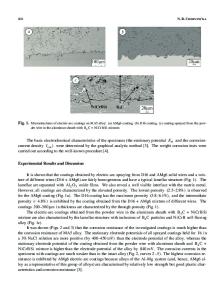Stress Corrosion Resistance of Laser Shock Peening/Microarc Oxidation Reconstruction Layer Fabricated on AZ80 Magnesium
- PDF / 1,120,377 Bytes
- 7 Pages / 593.972 x 792 pts Page_size
- 65 Downloads / 325 Views
JMEPEG https://doi.org/10.1007/s11665-020-05076-2
Stress Corrosion Resistance of Laser Shock Peening/ Microarc Oxidation Reconstruction Layer Fabricated on AZ80 Magnesium Alloy in Simulated Body Fluid Ying Xiong
, Xiaxia Hu, Zeyu Weng, and Renguo Song
(Submitted October 10, 2019; in revised form July 30, 2020) Three types of surface treatments were performed on AZ80 magnesium (Mg) alloy by laser shock peening (LSP), microarc oxidation (MAO), and laser shock peening followed by microarc oxidation (LSP/MAO). The stress corrosion resistance of treated and untreated specimens was carried out using slow strain rate tensile testing at a strain rate of 5 3 1027/s in simulated body fluid. The influence of microstructure on the stress corrosion behavior was analyzed by x-ray diffraction, transmission electron microscopy, scanning electron microscopy, and electrochemical measurement. The results showed that the LSP/MAO specimen has a higher stress corrosion resistance compared to the AZ80 Mg alloy substrate, the LSP-treated specimen, and the MAO-treated specimen. The factors improving the stress corrosion resistance of the LSP/ MAO specimen are its nanocrystalline material, compressive residual stress, and favorable (0002) basal texture of its reconstructed layer. Keywords
laser shock peening, magnesium, microarc oxidation, microstructure, stress corrosion
1. Introduction In the field of biomaterials, magnesium alloys have drawn increasing attention owing to their biodegradability and good mechanical properties (Ref 1). The mechanical strength, density, and elasticity of the magnesium alloy are very close to those of natural bone tissues. A second surgical operation can be avoided when magnesium alloys are used as bone implants (Ref 2-4). However, in orthopedics applications, magnesium alloys are used as temporary implants owing to their rapid degradation rate that leads to early failure of their mechanical strength. This is a major obstacle for their clinical application. Surface modification is an effective way of improving the degradation rate of magnesium alloys. MAO method is widely used for surface modification of titanium and magnesium alloys. The ceramic coating formed by MAO treatment not only enhances the corrosion resistance of titanium and magnesium alloys but also embeds them with excellent wear resistance and bonding strength. Recently, this method has been applied to biodegradable magnesium alloys. However, the inadequate biological activity of MAO coating is not conducive to biomedical applications (Ref 5). Another
Ying Xiong, Xiaxia Hu, and Zeyu Weng, College of Mechanical Engineering, Zhejiang University of Technology, Hangzhou 310023, China; and Key Laboratory of Special Purpose Equipment and Advanced Processing Technology, Ministry of Education and Zhejiang Province, Zhejiang University of Technology, Hangzhou 310023, China; Renguo Song, School of Materials Science and Engineering, Changzhou University, Changzhou 213164, China. Contact e-mail: [email protected].
Journal of Materials Engineering and Perf
Data Loading...











